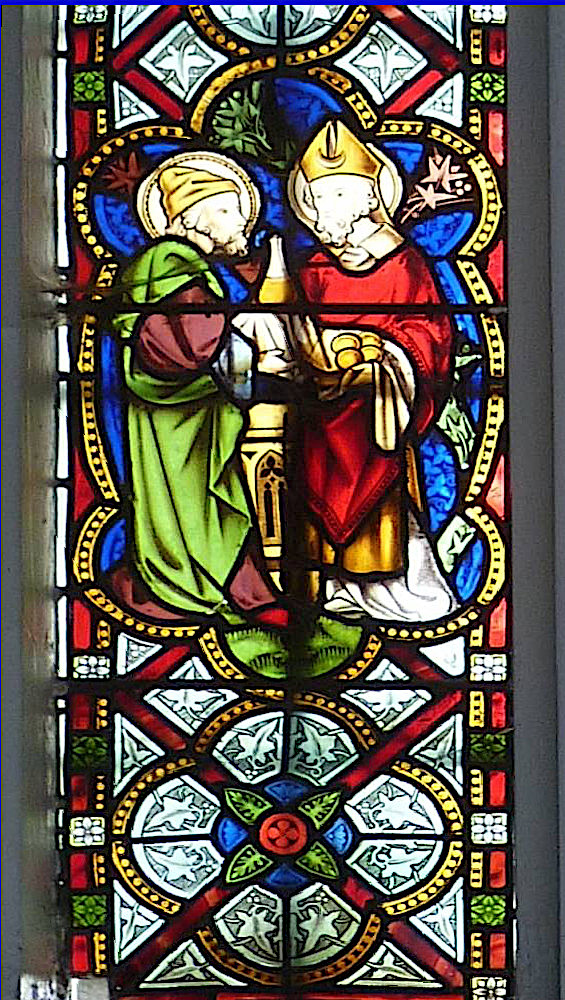[Photographs by the author. Click on thumbnails for larger images. You may use these and the following images without prior permission for any scholarly or educational purpose as long as you (1) credit the photographer and (2) link your document to this URL in a web document or cite it in a print one.]
East Window



Left to right: (a) The central light of the east window, showing the Madonna and Child. It is beautifully conceived, its details specific to the church. For example, the Madonna stands on a crescent moon, with two blue bands below it, the upper one studded by stars, the lower one patterned with waves. Beneath these, four mariners send up their urgent prayers from a sailing ship which is being buffeted by a storm. N.B. The crucifix here is standing on the altar in front of the window. (b) The whole window, which depicts the Annunciation and the Nativity on the left, and the Assumption and the Coronation in Heaven on the right. (c) The light showing the Nativity, just left of centre, a traditional scene with Joseph by his wife's side, the ox and the ass by the manger, and a little lantern lighting the scene. The canopies, gables and borders are all very finely detailed, as is the tracery. Two more angels hold emblems above, and the lovely wheel depicts fluid, floating angels.


Left: Close-up of the beleaguered mariners praying to the Madonna and Child, in the lower part of the central panel. Right: Two angels holding an emblem of the Madonna — a white rose, like the one she holds in her hand in the central panel. A similar scene is repeated below the other three lights. There has been some doubt about the attribution of the east window, because the architect of the church, William Wardell, had himself sketched an east window for the church. But Pugin had been highly dismissive of it: "it is a wretched job the tracery will bear no proportion to the lights," he had complained (qtd. in Shepherd 249). He then appears to have taken over, writing at last, "They have made a famous job of the Greenwich group it is quite fine work far exceeds my expectations & will do us much credit it is a real fine thing harmonious in colour & will quite delight you" (qtd. in Shepherd 249). Wardell did later design some "admirable" stained glass windows (see Hobhouse on his St Mary and St Joseph, Canton Street, Poplar [1851-56], destroyed in the war); but the consensus now is that this window is Pugin's work (see Eberhard as well as Shepherd's entry in his Gazetteer, 248-49).
Windows in the Blessed Sacrament Chapel




Left to right: (a) East window of the Blessed Sacrament Chapel, showing the Good Shepherd in the central light. Jesus holds a shepherd's crook, and cradles a lamb. Again, there is a crucifix just in front of the window here, rather obscuring the lamb. (b) To the left of the Good Shepherd, Melchizedek offers bread and wine to Abraham: "And Melchizedek king of Salem brought forth bread and wine: and he was the priest of the most high God" (Genesis 14, v. 18). This iconic scene illustrates the sacramental tradition (cf. the sculpted reredos in St. John the Baptist, Cardiff). (c) The light on the right of the Good Shepherd depicts Abraham's dutiful willingness to sacrifice Isaac. The tracery here is also very beautiful, "filled with a white and yellow silver stain floral grisaille [shades of the same colour, often grey] and red-rimmed roundels containing yellow flowers and blue, red and green rosettes" (Shepherd 248). (d) South window in the same chapel, showing an angel with a scroll, bearing a text giving thanks for Holy Communion ("Panem ... Alleluia"). Since Pugin designed the interior of this chapel, there is no doubt that the windows here were his own work, as indeed were tracery and clerestory windows elsewhere in the church.
Related Material
References
Eberhard, Robert. Stained glass windows at Our Ladye Star of the Sea (R.C.). Church Stained Glass Windows. Web. 4 June 2012.
Egan, Michael. Private Correspondence, kindly photocopied for the author by Father Kevin Robinson at the church, and drawn on here with Michael Egan's permission.
Hobhouse, Hermione, ed. "Poplar New Town: Infirmary, churches, schools and almshouses." Survey of London: volumes 43 and 44: Poplar, Blackwall and Isle of Dogs (1994). 202-207. British History Online. Web. 5 June 2012.
Shepherd, Stanley A. The Stained Glass of A. W. N. Pugin. Reading: Spire Books, 2009 (see especially the Gazetteer, pp. 248-49). Print.
Last modified 15 June 2012